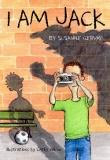Back in June and July I did a series of posts on the process of turning an idea into a story. (Those essays are under the tag "developing ideas"). A story has four main parts: idea, complications, climax and resolution. I’ve talked a lot about getting off to a strong start and developing the middle of the story. Last week I talked about the climax. Now let’s look at how stories wind down—the resolution.
The climax ends with the resolution. You could say that the resolution finishes the climax but comes from the idea: it’s how the main character finally meets that original challenge.
The climax ends with the resolution. You could say that the resolution finishes the climax but comes from the idea: it’s how the main character finally meets that original challenge.
In almost all cases the main character should resolve the situation himself. Here’s where many beginning children’s writers fail. It’s tempting to have an adult—a parent, grandparent, or teacher, or even a fairy, ghost or other supernatural creature—step in to save the child or tell him what to do.
That’s a disappointment for two reasons. First, we’ve been rooting for the main character to succeed. If someone else steals the climax away from him, it robs the story of tension and feels unfair. Second, kids are inspired by reading about other children who tackle and resolve problems. It helps them believe that they can meet their challenges, too. When adults take over, it shows kids as powerless and dependent on grownups. So let your main character control the story all the way to the end!
That’s a disappointment for two reasons. First, we’ve been rooting for the main character to succeed. If someone else steals the climax away from him, it robs the story of tension and feels unfair. Second, kids are inspired by reading about other children who tackle and resolve problems. It helps them believe that they can meet their challenges, too. When adults take over, it shows kids as powerless and dependent on grownups. So let your main character control the story all the way to the end!
Child characters can receive help from others, though, including adults. In I Am Jack by Susanne Gervay (Tricycle Press,
2009), Jack faces bullying. He solves his problem, in part, by asking for help.
In the end, Jack stands up for himself, but with the support of family,
teachers, and friends. It’s a realistic ending that inspires kids to take
charge in their own lives.
Though your main character should be responsible for the resolution, she doesn’t necessarily have to succeed. She might, instead, realize that her goals have changed. In My Big Nose and Other Natural Disasters by Sydney Salter (HM Harcourt, 2009), Jory starts out thinking that she needs a nose job to change her life. After a series of humorous disasters, Jory decides she really doesn’t need surgery to feel better about herself.
Though your main character should be responsible for the resolution, she doesn’t necessarily have to succeed. She might, instead, realize that her goals have changed. In My Big Nose and Other Natural Disasters by Sydney Salter (HM Harcourt, 2009), Jory starts out thinking that she needs a nose job to change her life. After a series of humorous disasters, Jory decides she really doesn’t need surgery to feel better about herself.
Stories for
younger children generally have happy or at least optimistic endings, even if
the original goal changes. Teen stories may be ambiguous or even unhappy.
Unhappy endings are probably most common in “problem novels,” such as stories
about the destruction of drug addiction. The main character’s failure acts as a
warning to readers.
This principle is
equally important when writing for adults. Don't fall back on deus ex machina, the Calvary to the rescue, etc. Your
main character should solve the problem. Even in today's romance novels, the
heroine is more likely to rescue herself (and maybe the hero) than to let the
hero do all the work.
Tip: How the main character resolves the situation—whether she succeeds or fails, and what rewards or punishments she receives—will determine the theme. Ask yourself:
Tip: How the main character resolves the situation—whether she succeeds or fails, and what rewards or punishments she receives—will determine the theme. Ask yourself:
What am I trying to accomplish? Who am I trying to reach? Why am I writing this?
Once you know
your theme, you know where the story is going, and how it must be resolved. In My Big Nose and Other Natural
Disasters, Salter wanted to show that happiness comes from within, rather
than from external beauty. Therefore, Jory had to learn that lesson, even if it
conflicted with her original goal of getting a nose job.



Hi Kris,
ReplyDeleteYour post was excellent as always.
The tips and resources you offer definitely help with my writing.
Thanks,
Tracy